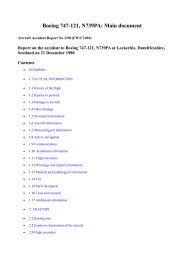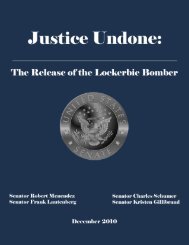REPORT OF THE - Archives - Syracuse University
REPORT OF THE - Archives - Syracuse University
REPORT OF THE - Archives - Syracuse University
Create successful ePaper yourself
Turn your PDF publications into a flip-book with our unique Google optimized e-Paper software.
information transmitted to Pan Am on November 18, 1988, had confirmed that physical<br />
search of unaccompanied baggage, among other procedures, was to be "rigorously<br />
applied."<br />
Testifying before the Commission, Mr. Salazar agreed that Pan Am's substitute X-ray<br />
procedure constituted "a violation of noncompliance." Nevertheless, all reference to the<br />
absence of the required passenger/baggage match procedure for interline baggage loaded<br />
on Flight 103 at Frankfurt was deleted from the FAA's official "letter of investigation"<br />
concerning the flight, as a result of comments from a senior official in Mr. Salazar's<br />
office that more specifics were needed. The FAA subsequently emphasized that its civil<br />
penalty letter contained "no allegations that any of the violations contributed to the Flight<br />
103 tragedy."<br />
As to the necessity for a formal FAA exemption permitting the substitute X-ray<br />
procedure, the Commission notes that Pan Am also had not sought or received such an<br />
exemption from the FAA's standard requiring Pan Am to search its service employees at<br />
Frankfurt airport. Pan Am testified it had a "working agreement" with the FAA since at<br />
least April 1986 on this subject. For several years Pan Am did not search its uniformed<br />
maintenance employees at Frankfurt airport but was not cited by the FAA for such a<br />
violation.<br />
Another U.S. carrier with operations at Frankfurt airport did formally request an<br />
exemption from the FAA in October 1988 that would permit X-ray rather than physical<br />
search of unaccompanied baggage in certain circumstances. The FAA denied the request,<br />
but not until April 1989 - four months after Flight 103 had been destroyed, the interline<br />
baggage lapse had been identified and the FAA had tightened its passenger/baggage<br />
requirements.<br />
The FAA provided the Commission with an April 20, 1990 survey of 53 FAA agents who<br />
had inspected Section XV airports during 1988. No inspector recalled a U.S. carrier<br />
substituting X-ray for physical search of unaccompanied baggage or stating it had done<br />
so.<br />
The Commission is not in a position to resolve the direct conflict between sworn<br />
testimony of Pan Am and FAA officials. Nor is it necessary to do so.<br />
Unquestionably, the circumstances surrounding Pan Am's interline baggage procedure at<br />
Frankfurt on December 21, 1988, are of direct, if not critical, importance to the question<br />
of how the bomb could have been placed on Flight 103.<br />
The undisputed facts before the Commission show that passenger/baggage reconciliation<br />
is a bedrock component of any heightened security system; that Pan Am employees<br />
concededly did not follow even the FAA's written reconciliation requirement for interline<br />
baggage at Frankfurt; and that the FAA did not cite Pan Am for failing to follow the<br />
FAA's mandated procedure in that respect for Flight 103.<br />
Finally, given the high level of threat warning in Frankfurt during December 1988,<br />
nothing prevented Pan Am from instituting, or the FAA from imposing, complete<br />
passenger/bag reconciliation just as was done in January 1989.<br />
The systems, both private and public, which allowed the interline baggage gap to<br />
continue, were fundamentally flawed.<br />
Warning Information<br />
Commission staff has reviewed intelligence traffic that, even in retrospect, would appear<br />
to have warned of a possible terrorist act such as Flight 103. The review showed that no










